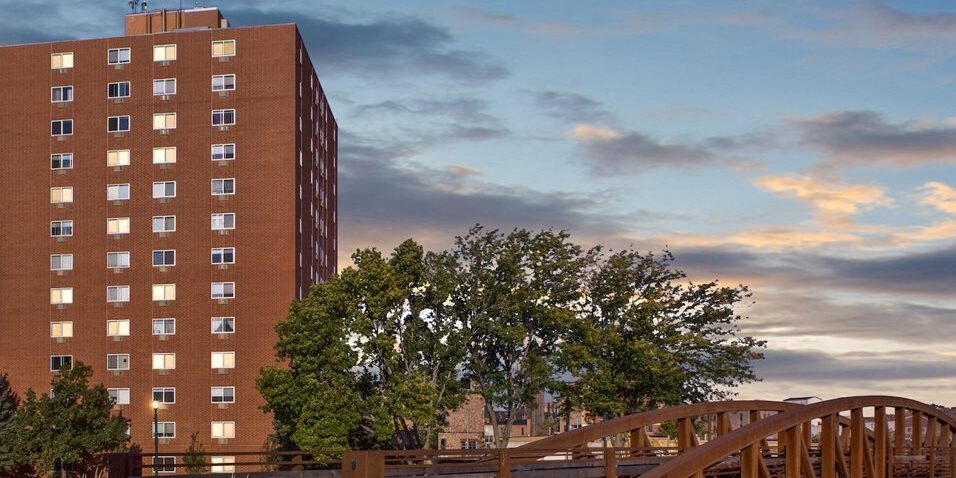Midcentury modern home study could lead to historic designations for neighborhoods
When Hugh and Janet Grogan moved to a house on South First Avenue, neighbors told them it had been patterned after residences in Arizona and called it “Southwest style.”

But according to a recent survey of midcentury modern homes in Sioux Falls, the Grogan house more properly should be listed as a rare example of “Storybook style” with its side gable and lattice work over the casement windows.

“I like ‘Storybook style’ better,” Hugh Grogan said recently when details of his 64-year-old residence were shared with him. “It’s fun and interesting to know the history of where you live and the people who preceded you and built up the neighborhood.”
Data about the home of the Grogans and the residences of hundreds of other Sioux Falls residents can be found in the document Mid-Century Modern Domestic Architecture. Diane de Koeyer, neighborhood and preservation planner for the city, said the information was compiled to determine if city neighborhoods have enough inventory to qualify as a historic district. If they do receive that designation, she said, “then they get protection from possibly making large changes to those properties.”

Mid-Century Modern Domestic Architecture, which has not yet been posted on the city’s website, was compiled by local preservation consultant Richard Jensen. He determined three neighborhoods would qualify for historic district designation: the Arcadia Heights, Sunny Crest and Teslow additions.
Information on the neighborhoods likely will be shared before spring 2022, and residents in those neighborhoods will be given the chance to decide if they want to proceed. Sioux Falls currently has five residential historic districts and two historic business districts, de Koeyer said: All Saints, Cathedral, Downtown, Hayes, McKennan, Old Courthouse & Warehouse, and Sherman.
The neighborhood most recently surveyed includes homes mostly built in the 1960s. Its boundaries are Phillips to Cliff avenues from 33rd to 38th streets. An aerial photograph from 1958 shows 73 homes in that area. By 1971, it had increased to 252. Now, there are 305 individual properties.

Sunny Crest is a realistic candidate for district nomination, according to Jensen’s survey, because it has well-preserved houses built between 1938 and 1962 with 16 of the 18 coming before 1952.
In Teslow’s Second Addition, the period of significance is 1957 to 1972, when 22 of the 23 properties were built. The Arcadia Heights recommendation includes Smith-McGreevy, Sunnyslope and the first Arcadia Heights additions. They were built out steadily eastward starting in 1954.
The Grogans’ house in the Grandview Addition is one of only eight properties on its block. Six fit into the survey’s guidelines, but that area is too small for a stand-alone nomination and has no outstanding historic aspects, Jensen’s survey reported.
Grogan likely would have welcomed such a nomination, he said.
“I would support it just because it helps to preserve a neighborhood to ensure stability,” he said.
Not everyone agrees. Several years ago, a city effort to interest the Pendar Lane neighborhood into applying for historic district status failed.
“A couple of neighbors, in my opinion, had some misinformation and thought the city and state could dictate what color they could paint their house,” de Koeyer said. “They put out a campaign to not have the neighborhood listed. One owner went ahead and pursued an individual listing though.”
Supporters of residential districts generally want to protect their character, de Koeyer said. Sioux Falls in recent years has seen several older homes torn down and replaced with much larger residences. Sometimes out-of-character materials are used in new houses, making then stand out that much more.

“Our modern vehicles aren’t fitting into new garages,” de Koeyer said, pointing out one issue that leads new buyers to desire a change. The Historic Preservation Board wants to make sure people can live in and function in new dwellings while maintaining a neighborhood’s integrity.
The furor over the Sapienza house built on Second Avenue across from McKennan Park happened before de Koeyer joined the city, she said. The Historic Preservation Board had approved an original architect’s design, and then the owners had the contractor redesign it. When the building permit came up for approval, the city was unaware the house had been redesigned and was much larger now. The house was built and eventually torn down.
Since then, the application and review processes have changed, de Koeyer said.
“The five residential districts have over 800 properties,” she said. “We want to be careful how things are approved. One person can change an entire neighborhood, and it sets a precedent. The board is really good about making sure things are consistent.”
Jensen’s report, when it goes online, also will offer homeowners and local historians multiple other insights into the Sioux Falls housing and construction market of the past, including information on neighborhoods that restricted who could live there.

W.L. Baker Addition is a roughly 16-block area east of McKennan Park. Platted in 1915, it included requirements on type and value of structure, setbacks and use of property. The Riverview Heights Addition off Kiwanis Avenue was more explicit, barring sale of property to anyone of color. Those restrictions were followed for the Sunny Crest Addition included in this survey.
Regional traits also are examined. Houses in this region, for example, were built with basements more often than in other regions. To make up for that added cost, most homes were sold without amenities such as central air and stoves.

When the Grogans can access the report, they will learn details about their house such as the bedroom wing projecting outward from the living room results “in a complicated roof intersection near the main entry.” They now know the house also has a “false dovecote” on the garage’s gable side even if they’re not sure it is an asset.
“It let bats in the house,” Grogan said. “We screened it off.”
Future surveys
Jensen’s report also suggests three areas that could be surveyed for historic-district status:
- L Baker Addition: Fourth Avenue to 21st Street to Seventh Avenue to 26th Street. This was the first restricted residential district in Sioux Falls.
- The Valley Park Additions: Fourth Avenue to 38th Street to Cliff Avenue to 41st Street. This is an example of a merchant builder neighborhood.
- Tuthill Park Hills: Cliff Avenue to 49th Street to Lewis Avenue to Tuthill Park. Arcadia Heights represents a late example of the neighborhood development process that prevailed before World War II, while Tuthill Park Hills represents an early example of modern methods applied to this class of housing.
Share This Story
Most Recent
Videos
Want to stay connected to where you live with more stories like this?
Adopt a free virtual “pigeon” to deliver news that will matter to you.





























